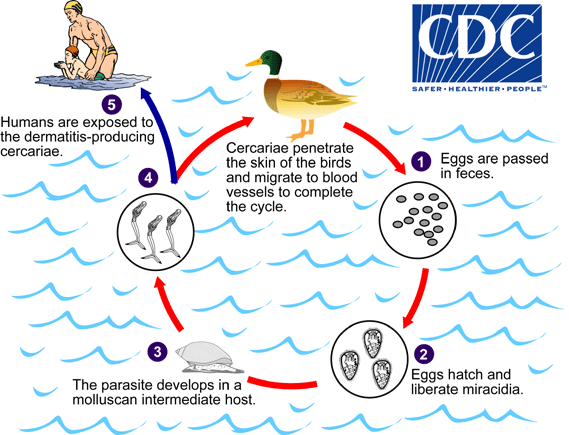Biology
Causal Agent:
Cercarial dermatitis is caused by the cercariae of certain species of schistosomes whose normal hosts are birds and mammals other than humans. These cercariae seem to have a chemotrophic reaction to secretions from the skin and are not as host-specific as other types of schistosomes. They attempt to, and, sometimes may actually, enter human skin. The penetration causes a dermatitis which is usually accompanied with intense itching, but the cercariae do not mature into adults in the human body. Cases of cercarial dermatitis can occur in both fresh and brackish water environments. One species of schistosome often implicated in cases of cercarial dermatitis is Austrobilharzia variglandis, whose normal hosts are ducks. The snail, Nassarius obsoletus, is the intermediate host for this species and can be found at marine beaches in temperate climates. Cercarial dermatitis should not be confused with seabather's eruption, which is caused by the larval stage of cnidarians (e.g., jellyfish). The areas of skin affected by seabather's eruption is generally under the garments worn by bathers and swimmers where the organisms are trapped after the person leaves the water. Cercarial dermatitis occurs on the exposed skin outside of close-fitting garments.
Life Cycle:

Hosts of avian schistosomes can be either year-round resident or migratory birds, including seagulls, shorebirds, ducks, and geese. Adult worms are found in the blood vessels and produce eggs that are passed in the feces  . On exposure to water, the eggs hatch and liberate a ciliated miracidium that infects a suitable snail (gastropod) intermediate host
. On exposure to water, the eggs hatch and liberate a ciliated miracidium that infects a suitable snail (gastropod) intermediate host  . The parasite develops in the intermediate host
. The parasite develops in the intermediate host  to produce free-swimming cercariae that are released under appropriate conditions and penetrate the skin of the birds and migrate to the blood vessels to complete the cycle
to produce free-swimming cercariae that are released under appropriate conditions and penetrate the skin of the birds and migrate to the blood vessels to complete the cycle  . Humans are inadvertent and inappropriate hosts; cercariae may penetrate the skin but do not develop further
. Humans are inadvertent and inappropriate hosts; cercariae may penetrate the skin but do not develop further  . A number of species of trematodes with dermatitis-producing cercariae have been described from both freshwater and saltwater environments, and exposure to either type of cercaria will sensitize persons to both.
. A number of species of trematodes with dermatitis-producing cercariae have been described from both freshwater and saltwater environments, and exposure to either type of cercaria will sensitize persons to both.
Life cycle image and information courtesy of DPDx.
- Page last reviewed: January 10, 2012
- Page last updated: January 10, 2012
- Content source:


 ShareCompartir
ShareCompartir